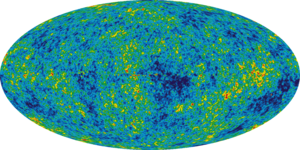Blue shift
| Physical cosmology | ||||||||||||||
 |
||||||||||||||
| Universe · Big Bang Age of the Universe Timeline of the Big Bang Ultimate fate of the universe
|
||||||||||||||

Blue shift is the shortening of a transmitted signal's wavelength, and/or an increase in its frequency, due to the Doppler Effect, which indicates that the object is moving toward the observer. The name comes from the fact that the shorter-wavelength end of the optical spectrum is the blue (or violet) end, hence, when visible light is compacted in wavelength, it is shifted towards the "blue" end of the spectrum, and is therefore said to be "blue-shifted". Since the longer-wavelength end of the visible electromagnetic spectrum is red, the opposite effect, of a lengthening of a signal's wavelength, is referred to as redshifting.
These terms and conventions ("blue" = compaction, "red"=stretching) are used even when referring to signals outside the optical range (for instance, radio waves, x-rays and gamma rays).
The term is also used informally to refer to a hypsochromic shift in photochemistry.
Astronomy
Redshift is much more noted due to its importance to modern astronomy. While the general redshift of starlight is seen as evidence for an expanding universe, there are a few examples of blue shift in astronomy:
- The Andromeda Galaxy is moving towards our own Milky Way Galaxy within the Local Group; thus, when observed from earth, its light is undergoing a blue shift.
- When observing spiral galaxies, the side spinning towards us will have a slight blue shift (see Tully-Fisher relation).
- Also, Blazars are known to propel relativistic jets towards us, emitting synchrotron radiation and Bremsstrahlung that appears blue shifted.
- Nearby stars such as Barnard's Star are moving towards us, resulting in a very small blue shift
Cause of blueshift in astronomy
These are the known possible causes of blue shift in astronomy:
- Movement of the source towards us, as seen in
- the edge of a rotating galaxy moving towards us
- In blazars which propel relativistic jets towards us
- Some galaxies [1] and quasars [2]
- Gravitational effects. See gravitational redshift